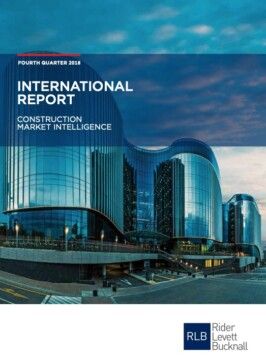According to the Rider Levett Bucknall (RLB) 4th Quarter 2018 International Report, rises in escalation are forecast for key Australian construction markets on the back of strong activity in the region.
Ewen McDonald, Oceania Chairman of RLB said, ‘The Australian economy has entered its 27th consecutive year of growth, exceeding expectations and rising at the fastest pace in six years. Real GDP is forecast to accelerate to above 3.0% for 2018 and 2019.’
According to the RLB International Report, construction activity in New South Wales continues to rise through 2018, with small increases in construction activity expected for the next three years. The non-residential and infrastructure sectors are the main drivers of construction growth, with the increased investment in roads and railways offering significant opportunities to the industry.
Limited resources in Sydney a major issue
The limited availability of resources in Sydney in all sectors, has become a major issue, with design consultants and contractors alike reporting difficulties in securing staff to undertake new work or to expand their businesses. At present, there is considerable demand for tradesmen to meet the available workload, putting pressure on trade pricing.
Ewen noted, ‘There is strong confidence within the Victorian construction industry, with both building work and engineering work done rising substantially over the past year. Victoria is seeing a transition within sectoral activity, with engineering work increasing its contribution to total construction work.
Significant infrastructure projects in Melbourne announced
‘With the commencement and announcement of a few significant civil/ infrastructure projects in Melbourne, a jump in construction costs and limited resources is currently being experienced and expected to continue during 2019. However, it is anticipated that the market will stabilise with the completion of these large building projects towards the end of 2019,’ he added.
Building activity in Queensland declines
Building activity in Queensland has seen a marginal decline from historically high levels seen during 2017. While residential building work has declined, engineering work has been rising.
Ewen continued, ‘We have seen Brisbane construction costs flatten during 2018 due to the slowdown in the pipeline of residential work. As work picks up for the Queens Wharf and other large projects, it is expected that the tendered cost of Tier 1 subcontractor trades to increase, due to the limited number of subcontractors available to tender.’
‘The Gold Coast economy is now in a post Commonwealth Games phase and is very dependent on future infrastructure expenditure on the M1 Motorway and Stage 3 of the Light Rail,’ he added.
Public sector projects active in South Australia
In South Australia, public sector projects remain very active with many projects under construction and new projects coming into the market. Numerous large civil projects are still under construction, keeping the sector busy.
Expectations across Adelaide are that prices for both the head and trade contractors will increase above inflation forecasts. Engineering services trades are also becoming busier, and as such, pricing in this area is becoming more erratic.
Western Australia showing signs of economic recovery
The Western Australian economy is showing early emerging signs of economic recovery. The office leasing market is seeing increased levels of activity in Premium and A-Grade stocks. Within Perth, there are some signs that slightly higher construction volumes will be seen, however, changes in escalation are not anticipated until 2019.
The RLB report found the Northern Territory’s construction industry remains flat with spare capacity. As defence projects begin to ramp up, it is anticipated that they will have flow-on effects to other sectors.
Canberra activity remains high
Although the ACT has seen sustained growth in activity for infrastructure and urban renewal projects, it is expected that this level of growth will not be sustainable in the medium to long term. Activity in Canberra remains high, with annual TPI movements averaging 3.5% over the next few years, which is ahead of the current headline inflation rate of 2.8%.
For 2019, RLB is forecasting construction cost growth of 4.0% in Adelaide, 4.1% in Brisbane, 3.2% in Canberra, 1.2% in Darwin, 3.0% in the Gold Coast, 3.5% in Melbourne, 2.5% in Perth, 3.9% in Sydney and 3.5% in Townsville.
For most cities, 2019 forecasts show rises in escalation on the back of strong activity in the regions.
It is anticipated that in the long term the market will adjust to the pressures currently being experienced and as such, escalation forecasts for 2020 are lower at 3.0% for Melbourne and 3.5% for Sydney.
Download PDF: RLB Global Construction Market Intelligence Report Q4 2018
FURTHER INFORMATION:



